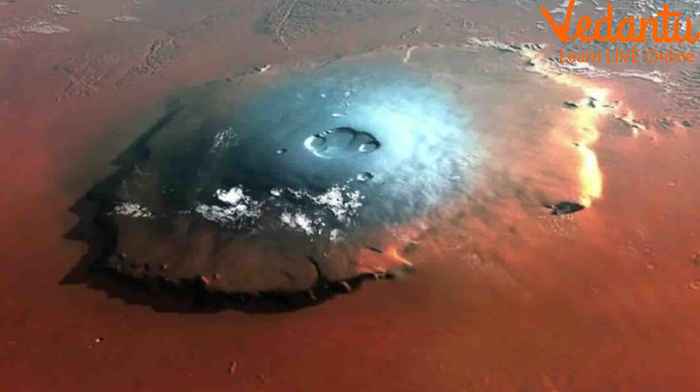Sample Test Depicts Mars Surface Water Dating Back Billions of Years
The never-ending curiosity of humans has led to the foundation of many marvellous achievements. The urge to fly made us invent aeroplanes. After 6 decades, we stepped for the first time on the moon. Now, we have found evidence of Mars surface water traces dating back billions of years.
The rovers navigating various craters and barren lands on Mars have detected the presence of water when the planet formed. The valuable information sent back by these robots has unveiled many new things about the Red Planet. One of them depicts the presence of water on this planet dating back to the formation of this planet.
The Discovery of Water on Mars
The age of Mars is almost the same as that of earth. It dates back 4.603 billion years. The rovers sent to this planet are continuously grabbing information and collecting data from its surface. They are relaying the information back to the earth and the scientists are working on it.
The latest mission Perseverance was launched on 30th July 2020. It was a seven-month journey through outer space. The scientists at NASA estimated that this rover will land on 18th February 2021 on Jerezo Crater, a 45-km wide depression located 20 degrees north of the equatorial line of Mars.
This planetary mission was very successful as it landed perfectly in the same location. It started collecting information at a height of 300 km regarding the Red Planet’s atmosphere. The landing procedure took 17 minutes. After landing, the car-sized rover started navigating the crater.
The evidence analysed after collecting samples from the surface of this crater suggested the prehistoric presence of water found on Mars. According to the evidence and studies done in the Jet Propulsion Laboratory (JPL) in NASA and the California Institute of Technology, this planet had a huge amount of water enough to cover it.
In fact, the abundance of water is so high that the planet might have been covered under water with a depth ranging from 100 m to 1500 m.
This water was present in the form of small lakes, pools, and deep oceans in different locations on this planet. Now that we know Mars had water billions of years ago, where did all the water go? Did it sustain microbial life? These questions are quite baffling for scientists. The rovers on the surface of this planet are collecting more information.
Water Traces Found on Mars by NASA
The traces of water have been found in the samples collected and analysed by the rovers. You should know a fact that rovers are navigating the surfaces whereas the Mars Express, a European Space Agency (ESA) satellite, is hovering over the planet.
This satellite has collected excellent evidence of the presence of water in the form of frozen lakes on Mars. This was a huge discovery proving the years-old theory of the presence of water found on Mars NASA.
This orbiting spacecraft has found that the regions near the south pole of this planet have water bodies underneath the ice caps. This discovery also suggests that nearly 30 to 99% of the surface water is trapped in the minerals present in the crust of this Red Planet.

Frozen Water Reservoirs in the Polar Region of Mars
Also Read: How Astronauts Live in Space?
In 2018, a rover scouting the surface of this planet hinted at the presence of a water reservoir in space of Mars. It also hinted that it can be the possible location where microbial life is supported. This finding was based on the evidence collected from 29 observations done between 2012 and 2015. According to researchers, this evidence was not enough to conclude anything. Hence, it still remains a hypothesis that needs stronger proof.
However, the latest discovery made by the hovering satellite has confirmed the presence of frozen water bodies in the southern polar region of this planet. The lakes are 75,000 sq. km in area. The central lake is the biggest one. It is 30 km wide and is surrounded by three smaller water reservoirs which are a few kilometres in width.
How did NASA find Water on Mars?
The discovery was made with a highly advanced instrument installed in the Mars Express orbiter to collect information. This device is called the Mars Advanced Radar for Subsurface and Ionosphere Sounding. In short, scientists call it MARSIS.
It is a 40-m long antenna installed in the ESA satellite hovering over Mars to send radio waves on the surface of Mars. It acts as radar that sends low-frequency of radio waves that hit and come back. The receiver traces the radio waves bounced by the topical layers of the Red Planet’s crust. The information is then analysed to check the presence of different minerals and water on the surface. It is also equipped with devices that can easily map and measure the elevation and roughness.
The radar reflectivity is also considered to analyse and understand the atmospheric conditions of this planet. In fact, it also takes information related to the interaction of solar winds with this planet’s ionosphere.
This radar technology concluded the NASA water Mars theory with solid evidence. It has made 134 observations between 2012 and 2019. The evidence has a huge data set that concludes the presence of frozen water bodies in the aforementioned polar regions of the planet.
Still a Debate
Despite the evidence collected, scientists will still need more evidence such as physical samples to ensure the presence of hidden water bodies on this planet. The size of Mars is 1/4th of the earth. It will take years to reach those locations to collect such samples.
NASA has collected residuals of water hidden in the minerals but the presence of frozen water reservoirs will need stronger evidence. With hope, we are carrying on the quest to find water.







